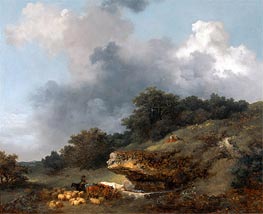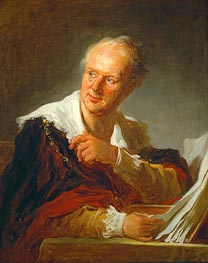
Jean-Honore Fragonard Giclée Fine Art Prints 4 of 4
1732-1806
French Rococo Painter
Jean-Honoré Fragonard (1732-1806) receives the Academy's first prize for painting and sculpture at the age of twenty. He studied at the Royal School for Protégés and in 1756 went to the French Academy in Rome. In the summer of 1760, supported by the friendship of his patron, the Jean-Claude Richard de Saint-Non, he produced marvellous drawings of the gardens of the Villa d'Este, ethereal landscapes, and casual, spontaneous genre scenes.
In 1765, he returned to Paris and presented a painting of a historical theme, "Coresus sacrificing himself to save Callirhoe", to the Salon. The triumph was incredible - the King bought the work and the author, extolled by specialists, won the favor of the Academy.
But he does not reciprocate the honours - he paints neither the canvas with which to be admitted into its bosom, nor the lofty commissions. He worked only for a private clientele, re-creating light and gallant subjects (The Swing, 1767). Fragonard is distinguished by a free, quick and energetic brushstroke. He executed an extraordinary series of fourteen portraits of figures in Spanish costume, 'figures of the imagination', some of whom were famous contemporaries of his (e.g. Denis Diderot), others leading to history or music. He was also a valuable decorator, as evidenced by the decoration of Madame du Barry's château in Louveciennes. Criticism ran rife, however, and the panels were withdrawn. Deeply hurt by these attacks, the artist set off again on a journey to Italy. There he added to his oeuvre a remarkable series of landscapes. After returning to Paris towards the end of 1774, his popularity declined, but Fragonard renewed his style: he handled harmonious combinations of lighter tones, with a finer texture, a technique which, without having lost its freedom, also drew on the Dutch masters.
In 1765, he returned to Paris and presented a painting of a historical theme, "Coresus sacrificing himself to save Callirhoe", to the Salon. The triumph was incredible - the King bought the work and the author, extolled by specialists, won the favor of the Academy.
But he does not reciprocate the honours - he paints neither the canvas with which to be admitted into its bosom, nor the lofty commissions. He worked only for a private clientele, re-creating light and gallant subjects (The Swing, 1767). Fragonard is distinguished by a free, quick and energetic brushstroke. He executed an extraordinary series of fourteen portraits of figures in Spanish costume, 'figures of the imagination', some of whom were famous contemporaries of his (e.g. Denis Diderot), others leading to history or music. He was also a valuable decorator, as evidenced by the decoration of Madame du Barry's château in Louveciennes. Criticism ran rife, however, and the panels were withdrawn. Deeply hurt by these attacks, the artist set off again on a journey to Italy. There he added to his oeuvre a remarkable series of landscapes. After returning to Paris towards the end of 1774, his popularity declined, but Fragonard renewed his style: he handled harmonious combinations of lighter tones, with a finer texture, a technique which, without having lost its freedom, also drew on the Dutch masters.
74 Fragonard Artworks
Page 4 of 4

Giclée Canvas Print
$66.81
$66.81
SKU: 13317-FJH
Jean-Honore Fragonard
Original Size:51.5 x 63 cm
Private Collection
Jean-Honore Fragonard
Original Size:51.5 x 63 cm
Private Collection

Giclée Canvas Print
$65.16
$65.16
SKU: 13293-FJH
Jean-Honore Fragonard
Original Size:81.5 x 65 cm
Louvre Museum, Paris, France
Jean-Honore Fragonard
Original Size:81.5 x 65 cm
Louvre Museum, Paris, France